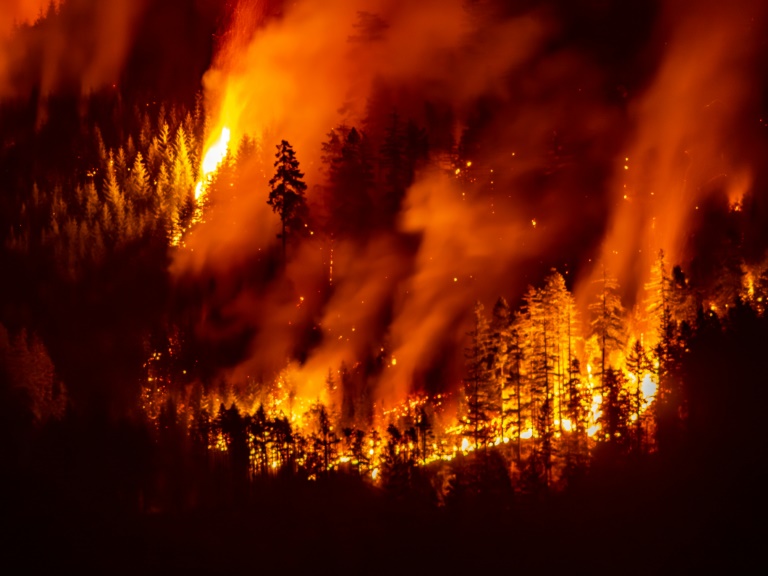World
Climate Change Fuels Wildfires, Worsening Air Quality in North America

Global air pollution is escalating, primarily driven by climate-induced wildfires in North America. A recent report from the Air Quality Life Index (AQLI) indicates that both the United States and Canada are experiencing significant increases in particulate matter, reversing decades of progress in air quality. The study, utilizing satellite data since 1998, translates pollution levels into potential years of life lost, underscoring the severe health impacts of air pollution.
The findings highlight a troubling trend: Canada experienced a staggering increase of over 50 percent in particulate levels during the catastrophic wildfire season of 2023, while the United States saw a 20 percent rise. According to Michael Greenstone, an economics professor at the University of Chicago and co-creator of AQLI, “Particulate matter remains the greatest external threat to human health on the planet, period.” He emphasized that its impact is more detrimental than tobacco smoke, child malnutrition, road accidents, or even HIV-AIDS.
As climate change continues to intensify, the trend of increasing air pollution is expected to persist. 2025 is already being projected as one of Canada’s worst wildfire seasons to date, contributing to a concerning trajectory for public health. Greenstone articulated that in certain regions, particularly in Canada and the United States, air pollution is akin to a “zombie that we thought we had killed,” indicating its resurgence.
Historically, the most polluted areas in the United States have been concentrated in California. However, the impact of Canadian wildfires is now shifting pollution towards states such as Wisconsin, Illinois, Indiana, and Ohio, as well as further south. Alarmingly, more than half of Canadians are now exposed to air pollution levels exceeding the national standard of 8.8 micrograms per cubic meter, a stark contrast to less than five percent in the previous five years.
The provinces of Northwest Territories, British Columbia, and Alberta have been the hardest hit. In these areas, particulate pollution levels have become comparable to those seen in Bolivia and Honduras, resulting in an estimated reduction in life expectancy by nearly two years.
On a global scale, fine particulate levels, defined as particles measuring 2.5 micrometers and smaller, rose from 23.7 micrograms per cubic meter in 2022 to 24.1 in 2023. This figure is almost five times higher than the World Health Organization guideline of five micrograms. In Latin America, pollution reached its highest level since 1998, with Bolivia being the worst affected country.
In South Asia, known as the world’s most polluted region, pollution levels increased by 2.8 percent. Even China, which had seen a decade of improvement under its “War on Pollution,” recorded a slight rebound in pollution levels.
Despite these alarming trends, there are some positive developments. Within the European Union, particulate concentrations decreased by six percent. Similarly, regions in Central and West Africa reported an eight percent drop in pollution levels.
The findings underscore the urgent need for concerted global efforts to address air quality and combat climate change. As the AQLI report illustrates, the health implications of rising air pollution are profound, making it imperative for governments and communities to take action to protect public health.
-

 Science2 months ago
Science2 months agoToyoake City Proposes Daily Two-Hour Smartphone Use Limit
-

 Health2 months ago
Health2 months agoB.C. Review Reveals Urgent Need for Rare-Disease Drug Reforms
-

 Top Stories2 months ago
Top Stories2 months agoPedestrian Fatally Injured in Esquimalt Collision on August 14
-

 Technology2 months ago
Technology2 months agoDark Adventure Game “Bye Sweet Carole” Set for October Release
-

 World2 months ago
World2 months agoJimmy Lai’s Defense Challenges Charges Under National Security Law
-

 Technology2 months ago
Technology2 months agoKonami Revives Iconic Metal Gear Solid Delta Ahead of Release
-

 Technology2 months ago
Technology2 months agoSnapmaker U1 Color 3D Printer Redefines Speed and Sustainability
-

 Technology2 months ago
Technology2 months agoAION Folding Knife: Redefining EDC Design with Premium Materials
-

 Technology2 months ago
Technology2 months agoSolve Today’s Wordle Challenge: Hints and Answer for August 19
-

 Business2 months ago
Business2 months agoGordon Murray Automotive Unveils S1 LM and Le Mans GTR at Monterey
-

 Lifestyle2 months ago
Lifestyle2 months agoVictoria’s Pop-Up Shop Shines Light on B.C.’s Wolf Cull
-

 Technology2 months ago
Technology2 months agoApple Expands Self-Service Repair Program to Canada









